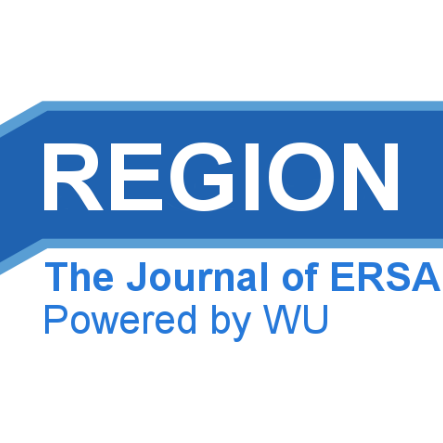Climate change in Lebanon: Higher-order regional impacts from agriculture
DOI:
https://doi.org/10.18335/region.v1i1.19Keywords:
Climate change, Economic Impacts, Agriculture, Integrated Modeling, Interregional CGE analysisAbstract
In this paper, we analyze the susceptibility of agricultural outputs to future climate change in Lebanon, and the extent to which it propagates to the economic system as a whole. We use a methodological framework in which physical and economic models are integrated for assessing the higher-order economic impacts of projected climate changes. By using this integrated modeling approach, we are able to quantify the broader economic impacts in the country by considering not only the temporal dimension but also the regional disaggregation of the results. Our estimates suggest that there are high potential costs and risks associated with a burden to the poorer and more vulnerable regions of the country.References
Agénor PR, Izquierdo A and Jensen HT (2007). Adjustment Policies, Poverty, and Unemployment: The IMMPA Framework. Oxford: Blackwell Publishing.
Council for Development and Reconstruction – CDR (2005). National Physical Master Plan for the Lebanese Territory, Beirut, Lebanon.
Food and Agriculture Organization of the United Nations – FAO (2014). FAOSTAT database. Available online at: http://faostat3.fao.org/faostat-gateway/go/to/home/E.
Giesecke JA and Madden JR (2006). CGE Evaluation of a University’s Effects on a Regional Economy: An Integrated Assessment of Expenditure and Knowledge Impacts. Review of Urban and Regional Development Studies, 18: 3, pp. 229-251.
Haddad EA (1999). Regional Inequality and Structural Changes: Lessons from the Brazilian Experience. Aldershot: Ashgate.
Haddad EA (2014a). Spatial Perspectives of Increasing Freeness of Trade in Lebanon. Annals of Regional Science, DOI 10.1007/s00168-014-0615-3.
Haddad EA (2014b). Trade and Interdependence in Lebanon: An Interregional Input-Output Perspective. Journal of Development and Economic Policies, v. 16, n. 1, pp. 5-45.
Huang H and Khanna M (2010). An Econometric Analysis of U.S. Crop Yield and Cropland Acreage: Implications for the Impact of Climate Change. Paper presented at the Agricultural & Applied Economics Association 2010 AAEA, CAES, & WAEA Joint Annual Meeting, Denver, Colorado, July 25-27, 2010.
IPCC (2013). Summary for Policymakers. In: Climate Change 2013: The Physical Science Basis. Contribution of Working Group I to the Fifth Assessment Report of the Intergovernmental Panel on Climate Change [Stocker TF, D Qin, GK. Plattner, M Tignor, SK Allen, J Boschung, A Nauels, Y Xia, V Bex and PM Midgley (eds.)]. Cambridge University Press, Cambridge, United Kingdom, and New York, NY, USA.
Ministry of Agriculture – MoA (2013). Production 2008-2009. http://www.agriculture.gov.lb/Arabic/DataAndAgriStatistics/AgriInLebanon/Documents/Enquete%20prod2008_2009.pdf
Ministry of Environment – MoE (1999). Lebanon’s Initial National Communication to the United Nations Framework Convention on Climate Change. Accessed online in June 2014 at: http://climatechange.moe.gov.lb/national-communications.
Ministry of Environment – MoE (2011). Lebanon’s Second National Communication to the United Nations Framework Convention on Climate Change. Accessed online in November 2013 at: http://www.moe.gov.lb/ClimateChange/snc.html
Ministry of Environment/Ecodit (2010). State of the Environment Report, Ministry of Environment, Beirut, Lebanon.
Palatnik RR and Roson R (2012) Climate Change and Agriculture in Computable General Equilibrium Models: Alternative Modeling Strategies and Data Needs. Climatic Change, 112 (3-4). pp. 1085-1100.
Peter MW, Horridge M, Meagher GA, Naqvi F and Parmenter BR (1996). The Theoretical Structure Of MONASH-MRF. Working Paper no. OP-85, IMPACT Project, Monash University, Clayton, April.
Saade C. (1994). Agricultural performance and policy in Lebanon. Cahiers Options Méditerranéennes, 70-95.
World Bank (2013). Country data. Accessed on-line in August 2013 at: http://data.worldbank.org/country/lebanon.
Published
How to Cite
Issue
Section
License
REGION is an open journal, and uses the standard Creative Commons license: Copyright We want authors to retain the maximum control over their work consistent with the first goal. For this reason, authors who publish in REGION will release their articles under the Creative Commons Attribution license. This license allows anyone to copy and distribute the article provided that appropriate attribution is given to REGION and the authors. For details of the rights authors grant users of their work, see the "human-readable summary" of the license, with a link to the full license. (Note that "you" refers to a user, not an author, in the summary.) Upon submission, the authors agree that the following three items are true: 1) The manuscript named above: a) represents valid work and neither it nor any other that I have written with substantially similar content has been published before in any form except as a preprint, b) is not concurrently submitted to another publication, and c) does not infringe anyone’s copyright. The Author(s) holds ERSA, WU, REGION, and the Editors of REGION harmless against all copyright claims. d) I have, or a coauthor has, had sufficient access to the data to verify the manuscript’s scientific integrity. 2) If asked, I will provide or fully cooperate in providing the data on which the manuscript is based so the editors or their assignees can examine it (where possible) 3) For papers with more than one author, I as the submitter have the permission of the coauthors to submit this work, and all authors agree that the corresponding author will be the main correspondent with the editorial office, and review the edited manuscript and proof. If there is only one author, I will be the corresponding author and agree to handle these responsibilities.




